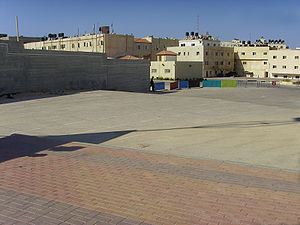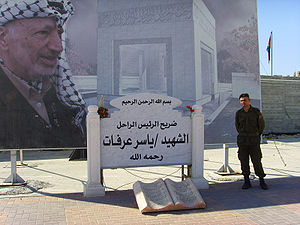- Mukataa
-
- See muqata'ah for the Ottoman instrument for financing state expenses.
Mukataa (Arabic: المقاطعة, "The Separated") is the name used to refer to the offices and administrative centers of the Palestinian National Authority.
Mukataas were mostly built during the British Mandate as Tegart forts and were used both as British government centers and as dwellings for the British administrative staff. Some Mukataas also included police stations and prisons. After the British left, the buildings often functioned similarly under the Jordanians, and then the Israelis.
After the Oslo Accords, the Mukataas were used as governmental offices and headquarters for the Palestinian National Authority. The Mukaatas in Ramallah and Gaza, the two major Palestinian cities, were also used as headquarters to the high Palestinian Authority leadership, including as office for Yasser Arafat, long-time Palestinian Authority president.
During Operation Defensive Shield in April 2002, the Israeli Defence Forces raided the Mukataas in the West Bank. Some Mukataas, including the Mukataa in Hebron, were entirely demolished.
Arafat's compound
The Mukataa in Ramallah, also known as Arafat's Compound was raided by the Israel Defense Forces and placed under siege on 29 March 2002 during Operation Defensive Shield. The siege was lifted in May 2002 after 6 men wanted by Israel for the killing of the Israeli tourism minister Rehavam Zeevi, were handed over.[1]
The US brokered plan was to enable Israel to avoid angering the United States over the Israeli Cabinet decision: Ministers decided to bar a U.N. fact-finding mission from investigating allegations surrounding Israeli army actions in Jenin refugee camp during operation Rampart.[2][3]
In September 2002 the compound was again placed under siege.
A UN security council resolution called for an immediate end to the siege, this Israel ignored.[4]
- The Israeli army's siege of Yasser Arafat amid the ruins of his bulldozed presidential compound could mean "the death" of hopes for a Palestinian state and a peace agreement,said Terje Roed Larsen the United Nations' most senior envoy to the Middle East.[5]
Larsen also linked the Israeli siege of Arafat to ending the possibility of a two-state solution.[5]
The second siege re-ignited Palestinian support for Yasser Arafat.[6] The Mukataa was later partially demolished by IDF armored bulldozers in order to isolate Arafat.[7]
At the time of his departure for medical care in Paris in October 2004, Arafat was under house arrest in the compound for over two years. In the early days of November, when it was clear his death was near, several locations were mentioned as possible burial sites. Jerusalem was the first choice, but Israeli Prime Minister Ariel Sharon said he would not allow this; and so, following Arafat's death on November 11, the Palestinian leadership decided that he was to be "temporarily" interred in the Mukataa compound, pending the establishment of a Palestinian state and the transfer of his body to the Dome of the Rock compound on the Temple Mount in Jerusalem. Plans for Arafat to lie in state at the Mukataa prior to burial were canceled, because thousands of emotional mourners overwhelmed Palestinian security forces. Arafat was buried within the compound on November 12, 2004, in a temporary manner. On November 11, 2007, a larger tomb clad in Jerusalem stone, and designed by Palestinian architects opened to the public. The message on the tomb indicated that the final resting place of Arafat shall be in Jerusalem, if it comes under Palestinian control.
Footnotes
- ^ Telegraph Arafat siege to end as handover agreed 01 May 2002
- ^ CBS Arafat Siege Could End Soon 29 April 2002
- ^ [Documents, working papers. 2002, vol. 4: Documents 9396-9428: working papers, 2002 ordinary session (second part), 22–26 April 2002, Vol. 4: Documents 9396-9428 by Council of Europe: Parliamentary Assembly Published by Council of Europe, 2002 ISBN 9287149178 p 207
- ^ Guardian Israel defies UN vote demanding end to Arafat siege by Jonathan Steele in Jerusalem 25 September 2002
- ^ a b Independent Israeli siege of Arafat 'is killing peace hope' By Justin Huggler Saturday, 28 September 2002
- ^ ABC Siege continues at Arafat's HQ by Mark Willacy 23 September 2002
- ^ Taylor & Francis Group, Taylor & Francis Group (2004) Europa World Year Book 2: Kazakhstan-Zimbabwe Published by Taylor & Francis, ISBN 185743255X p 3314
External links
- IDF Bulldozers tear down the Mukataa (Waronline.org Forums)
- "Arafat buried in Ram Allah" (Aljazeera)
Coordinates: 31°54′44.4″N 35°12′30.83″E / 31.912333°N 35.2085639°E
Categories:- Israeli–Palestinian conflict
- Arabic words and phrases
- Buildings and structures in the West Bank
- Palestinian National Authority
- Ramallah
- Tegart forts
Wikimedia Foundation. 2010.



